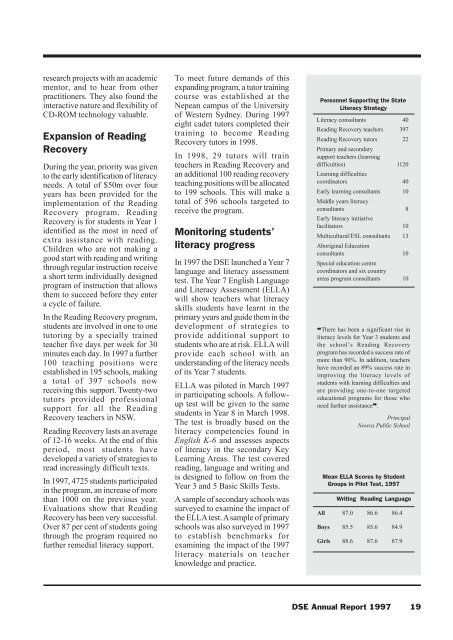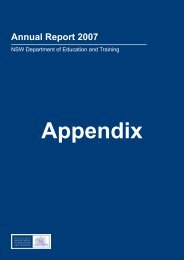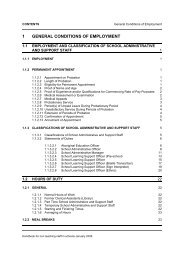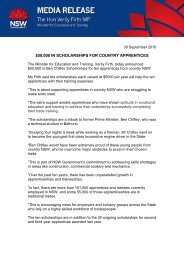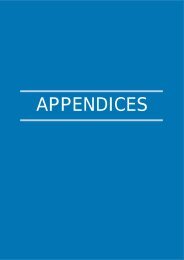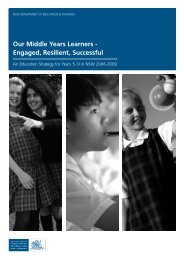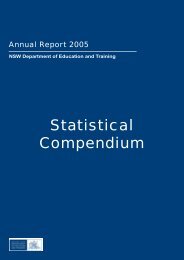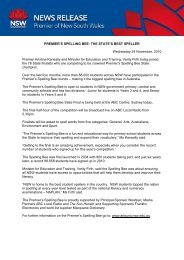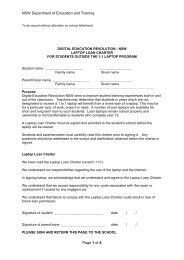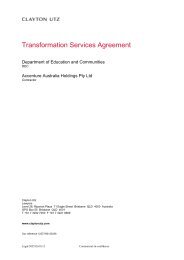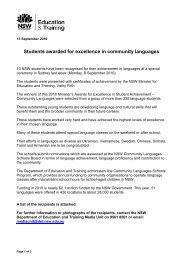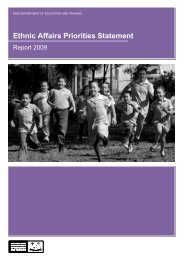01 - Department of Education and Communities - NSW Government
01 - Department of Education and Communities - NSW Government
01 - Department of Education and Communities - NSW Government
You also want an ePaper? Increase the reach of your titles
YUMPU automatically turns print PDFs into web optimized ePapers that Google loves.
esearch projects with an academicmentor, <strong>and</strong> to hear from otherpractitioners. They also found theinteractive nature <strong>and</strong> flexibility <strong>of</strong>CD-ROM technology valuable.Expansion <strong>of</strong> ReadingRecoveryDuring the year, priority was givento the early identification <strong>of</strong> literacyneeds. A total <strong>of</strong> $50m over fouryears has been provided for theimplementation <strong>of</strong> the ReadingRecovery program. ReadingRecovery is for students in Year 1identified as the most in need <strong>of</strong>extra assistance with reading.Children who are not making agood start with reading <strong>and</strong> writingthrough regular instruction receivea short term individually designedprogram <strong>of</strong> instruction that allowsthem to succeed before they entera cycle <strong>of</strong> failure.In the Reading Recovery program,students are involved in one to onetutoring by a specially trainedteacher five days per week for 30minutes each day. In 1997 a further100 teaching positions wereestablished in 195 schools, makinga total <strong>of</strong> 397 schools nowreceiving this support. Twenty-twotutors provided pr<strong>of</strong>essionalsupport for all the ReadingRecovery teachers in <strong>NSW</strong>.Reading Recovery lasts an average<strong>of</strong> 12-16 weeks. At the end <strong>of</strong> thisperiod, most students havedeveloped a variety <strong>of</strong> strategies toread increasingly difficult texts.In 1997, 4725 students participatedin the program, an increase <strong>of</strong> morethan 1000 on the previous year.Evaluations show that ReadingRecovery has been very successful.Over 87 per cent <strong>of</strong> students goingthrough the program required n<strong>of</strong>urther remedial literacy support.To meet future dem<strong>and</strong>s <strong>of</strong> thisexp<strong>and</strong>ing program, a tutor trainingcourse was established at theNepean campus <strong>of</strong> the University<strong>of</strong> Western Sydney. During 1997eight cadet tutors completed theirtraining to become ReadingRecovery tutors in 1998.In 1998, 29 tutors will trainteachers in Reading Recovery <strong>and</strong>an additional 100 reading recoveryteaching positions will be allocatedto 199 schools. This will make atotal <strong>of</strong> 596 schools targeted toreceive the program.Monitoring students’literacy progressIn 1997 the DSE launched a Year 7language <strong>and</strong> literacy assessmenttest. The Year 7 English Language<strong>and</strong> Literacy Assessment (ELLA)will show teachers what literacyskills students have learnt in theprimary years <strong>and</strong> guide them in thedevelopment <strong>of</strong> strategies toprovide additional support tostudents who are at risk. ELLA willprovide each school with anunderst<strong>and</strong>ing <strong>of</strong> the literacy needs<strong>of</strong> its Year 7 students.ELLA was piloted in March 1997in participating schools. A followuptest will be given to the samestudents in Year 8 in March 1998.The test is broadly based on theliteracy competencies found inEnglish K-6 <strong>and</strong> assesses aspects<strong>of</strong> literacy in the secondary KeyLearning Areas. The test coveredreading, language <strong>and</strong> writing <strong>and</strong>is designed to follow on from theYear 3 <strong>and</strong> 5 Basic Skills Tests.A sample <strong>of</strong> secondary schools wassurveyed to examine the impact <strong>of</strong>the ELLA test. A sample <strong>of</strong> primaryschools was also surveyed in 1997to establish benchmarks forexamining the impact <strong>of</strong> the 1997literacy materials on teacherknowledge <strong>and</strong> practice.Personnel Supporting the StateLiteracy StrategyLiteracy consultants 40Reading Recovery teachers 397Reading Recovery tutors 22Primary <strong>and</strong> secondarysupport teachers (learningdifficulties) 1120Learning difficultiescoordinators 40Early learning consultants 10Middle years literacyconsultants 8Early literacy initiativefacilitators 10Multicultural/ESL consultants 13Aboriginal <strong>Education</strong>consultants 10Special education centrecoordinators <strong>and</strong> six countryareas program consultants 10❝There has been a significant rise inliteracy levels for Year 3 students <strong>and</strong>the school’s Reading Recoveryprogram has recorded a success rate <strong>of</strong>more than 90%. In addition, teachershave recorded an 89% success rate inimproving the literacy levels <strong>of</strong>students with learning difficulties <strong>and</strong>are providing one-to-one targetededucational programs for those whoneed further assistance❞.PrincipalNowra Public SchoolMean ELLA Scores by StudentGroups in Pilot Test, 1997Writing Reading LanguageAll 87.0 86.6 86.4Boys 85.5 85.6 84.9Girls 88.6 87.6 87.9DSE Annual Report 1997 19


